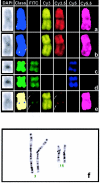Familial mental retardation syndrome ATR-16 due to an inherited cryptic subtelomeric translocation, t(3;16)(q29;p13.3)
- PMID: 10631133
- PMCID: PMC1288322
- DOI: 10.1086/302703
Familial mental retardation syndrome ATR-16 due to an inherited cryptic subtelomeric translocation, t(3;16)(q29;p13.3)
Abstract
In the search for genetic causes of mental retardation, we have studied a five-generation family that includes 10 individuals in generations IV and V who are affected with mild-to-moderate mental retardation and mild, nonspecific dysmorphic features. The disease is inherited in a seemingly autosomal dominant fashion with reduced penetrance. The pedigree is unusual because of (1) its size and (2) the fact that individuals with the disease appear only in the last two generations, which is suggestive of anticipation. Standard clinical and laboratory screening protocols and extended cytogenetic analysis, including the use of high-resolution karyotyping and multiplex FISH (M-FISH), could not reveal the cause of the mental retardation. Therefore, a whole-genome scan was performed, by linkage analysis, with microsatellite markers. The phenotype was linked to chromosome 16p13.3, and, unexpectedly, a deletion of a part of 16pter was demonstrated in patients, similar to the deletion observed in patients with ATR-16 syndrome. Subsequent FISH analysis demonstrated that patients inherited a duplication of terminal 3q in addition to the deletion of 16p. FISH analysis of obligate carriers revealed that a balanced translocation between the terminal parts of 16p and 3q segregated in this family. This case reinforces the role of cryptic (cytogenetically invisible) subtelomeric translocations in mental retardation, which is estimated by others to be implicated in 5%-10% of cases.
Figures





Similar articles
-
Familial complex 3q;10q rearrangement unraveled by subtelomeric FISH analysis.Am J Med Genet A. 2006 Jan 15;140(2):144-50. doi: 10.1002/ajmg.a.31042. Am J Med Genet A. 2006. PMID: 16353244
-
Familial MCA/MR syndrome due to inherited submicroscopic translocation t(18;21)(q22.1q21.3) with breakpoint at the Down syndrome critical region.Am J Med Genet A. 2003 Mar 15;117A(3):236-44. doi: 10.1002/ajmg.a.10017. Am J Med Genet A. 2003. PMID: 12599186 Review.
-
Subtelomeric chromosomal rearrangements detected in patients with idiopathic mental retardation and dysmorphic features.Genet Couns. 2005;16(2):129-38. Genet Couns. 2005. PMID: 16080292
-
Identification of a subtle t(16;19)(p13.3;p13.3) in an infant with multiple congenital abnormalities using a 12-colour multiplex FISH telomere assay, M-TEL.Eur J Hum Genet. 2000 Dec;8(12):903-10. doi: 10.1038/sj.ejhg.5200545. Eur J Hum Genet. 2000. PMID: 11175277
-
Interstitial deletion in 3q in a patient with blepharophimosis-ptosis-epicanthus inversus syndrome (BPES) and microcephaly, mild mental retardation and growth delay: clinical report and review of the literature.Am J Med Genet A. 2005 Aug 15;137(1):81-7. doi: 10.1002/ajmg.a.30786. Am J Med Genet A. 2005. PMID: 16015581 Review.
Cited by
-
An optimized set of human telomere clones for studying telomere integrity and architecture.Am J Hum Genet. 2000 Aug;67(2):320-32. doi: 10.1086/302998. Epub 2000 Jun 22. Am J Hum Genet. 2000. PMID: 10869233 Free PMC article.
-
Perfect endings: a review of subtelomeric probes and their use in clinical diagnosis.J Med Genet. 2000 Jun;37(6):401-9. doi: 10.1136/jmg.37.6.401. J Med Genet. 2000. PMID: 10851249 Free PMC article. Review.
-
Polygenic inheritance of cryptorchidism susceptibility in the LE/orl rat.Mol Hum Reprod. 2016 Jan;22(1):18-34. doi: 10.1093/molehr/gav060. Epub 2015 Oct 26. Mol Hum Reprod. 2016. PMID: 26502805 Free PMC article.
-
Refinement of the genetic cause of ATR-16.Hum Genet. 2007 Nov;122(3-4):283-92. doi: 10.1007/s00439-007-0399-y. Epub 2007 Jun 28. Hum Genet. 2007. PMID: 17598130
-
Telomeres: a diagnosis at the end of the chromosomes.J Med Genet. 2003 Jun;40(6):385-98. doi: 10.1136/jmg.40.6.385. J Med Genet. 2003. PMID: 12807958 Free PMC article. Review.
References
Electronic-Database Information
-
- The Genetic Location Database, http://cedar.genetics.soton.ac.uk/public_html (for inferred physical location of loci markers)
-
- Online Mendelian Inheritance in Man (OMIM), http://www.ncbi.nlm.nih.gov/Omim (for Cornelia DeLange syndrome [MIM 122370], Wolf-Hirschhorn syndrome [MIM 194190], cri-du-chat syndrome [MIM 123450], and Miller-Dieker syndrome [MIM 247200]
References
-
- Altherr MR, Wright TJ, Denison K, Perez-Castro AV, Johnson V (1997) Delimiting the Wolf-Hirschhorn syndrome critical region to 750 kilobase pairs. Am J Med Genet 71:47–53 - PubMed
-
- Alvarez Arratia MC, Rivera H, Möller M, Valdivia A, Vigueras A, Cantu JM (1984) De novo del(3)(q28). Ann Genet 27:109–111 - PubMed
-
- Curry CJ, Stevenson RE, Aughton D, Byrne J, Carey JC, Cassidy S, Cunniff C, et al (1997) Evaluation of mental retardation: recommendations of a consensus conference. Am J Med Genet 72:468–477 - PubMed
-
- Dib C, Fauré S, Fizames C, Samson D, Drouot N, Vignal A, Millasseau P, et al (1996) A comprehensive genetic map of the human genome based on 5,264 microsatellites. Nature 380:152–154 - PubMed
Publication types
MeSH terms
LinkOut - more resources
Full Text Sources
Research Materials
Miscellaneous

